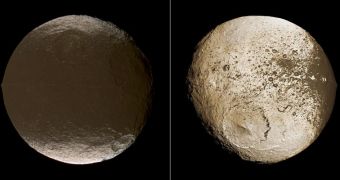Iapetus, one of the many moons orbiting Saturn, is unusual even among the gas giant's peculiar satellites. When viewed through telescopes, it appears as if it has two colors, and astronomers have been trying to figure out why that is for years. The answer may lie within Earth's ice sheets.
Scientists believe that this moon is covered in ice. One theory suggests that only its brightest half has ice on it, whereas the other is darker because it's covered in dust. Other explanations suggest that the darkened areas are in fact generated by the moon's motions around Saturn.
A thing that many astronomers agree on is that Iapetus did not look like this when it first formed. Most likely, it resembled any other icy moon in the solar system at the time, and got its two-toned appearance sometime over the past 4.6 billion years.
Data collected by the NASA Cassini spacecraft – which has been studying the gas giant, its moons and its rings since July 1, 2004 – suggests that the migrating ice theory is more likely. Some study groups are currently measuring Iapetus' microwave emissions to figure out what's going on.
“What makes Iapetus unusual is that it has one side that is dark and one side that is bright. There have been a couple attempts to look at the variation in temperature across the surface, but no one has actually done a rotational light curve,” Paul Ries says, quoted by Space.
“I was trying to get something continuous to look at the thermal variations,” adds the expert, who holds an appointment as a researcher with the National Radio Astronomy Observatory (NRAO). He is also a graduate student at the University of Virginia.
Microwave emissions and temperature signals recorded from Iapetus show a very weird radiation absorption pattern, which does not stick by the Planck curve.
“What I found was that the emissions were what we call flat, which means that as you go from one radio wavelength to another, the emissions were the same when you expect them to be declining,” the investigator says.
By cross-referencing data from the Saturnine moon with information collected of Earth's own ice sheets – by advanced satellites currently in terrestrial orbit – it may soon be possible to explain the unusual radiation absorption pattern seen at Iapetus.
Salinity content may be one of the factors playing an important role in this scenario, the expert says. The size and distribution of the ice crystals themselves may also be used to explain the moon's peculiarity.

 14 DAY TRIAL //
14 DAY TRIAL //